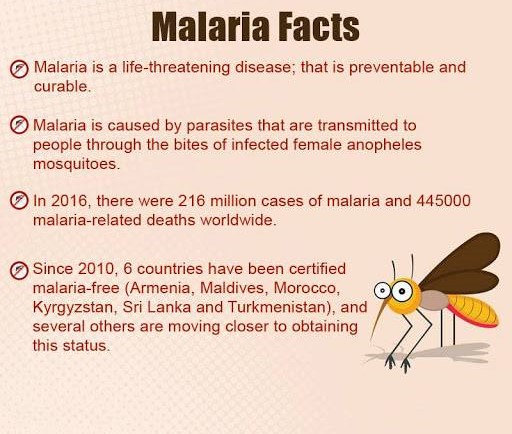April 23 (Punjab Khabarnama) : Since 2015, the number of malaria cases worldwide have stalled and ― in some areas, they’re even increasing. That’s after two decades of falling numbers. What’s going on?
In the 1990s, charities, governments and individual philanthropists invested billions of dollars into one goal: malaria control. They wanted to halve the global number of malaria deaths by 2010.
At the time, malaria represented one of the biggest health threats in the world. At least one million people were dying of the disease each year, the vast majority of them young children.
The “Roll Back Malaria” campaign officially launched in 1998. With billions of dollars in funding from global organizations like the World Health Organization and World Bank, partners started dispersing mosquito bed nets and indoor insecticide sprays in affected regions. They also introduced new drugs to treat patients in areas where the mosquitoes had grown resistant to chloroquine, the main antimalarial used at the time.
These efforts worked to nearly halve the number of malaria deaths in less than two decades.
Stagnation, then sharp increase in malaria case numbers
But in 2015, things started to stagnate. For the next few years, estimated cases stayed the same ― and then they started to rise.
In 2020, global malaria deaths hit their highest level in six years. And in 2022, the number of estimated global malaria cases shot up to more than 248 million, from around 230 million in 2014 .
These disappointing estimates prompted Nicholas White, a malaria scientist and professor of tropical medicine at the University of Oxford, to publish an appeal to the WHO in the Lancet medical journal. According to their own numbers, he said, the number of estimated malaria cases in 2000 were the exact same as the 2022 figure.
If this was true, he said, what was going wrong? Was it really the case that after billions of dollars of global investment, years of research on preventative therapies and the disbursement of billions of treatments, the number of cases had not budged?
The WHO responded to White’s question, saying that the had falsely interpreted the numbers because he hadn’t taken global population growth into account.
“If the global malaria incidence and mortality rate in 2000 were applied to populations at risk annually to 2020, the investments made over the past 20 years would have contributed to an estimated 11 million lives saved and 1.7 billion cases averted since 2000,” the WHO wrote.
Still, the organization acknowledged in the headline of their response that “The message on malaria is clear: progress has stalled.”
An ‘arms race’ to control malaria
The reasons for this stall are “complex”, the organization says. In its response to White, it explained that sub-Saharan Africa, the area most threatened by malaria, is seeing less funding for interventions and a lack of access to quality care. Available tools are compromised by “biological threats”, they said.
Experts consulted by DW said it is likely the stagnation is due, at least in part, to malaria-spreading mosquitoes’ ability to quickly adapt to and circumvent interventions.
Across the globe, many of the mosquitoes which spread malaria have become resistant to the main insecticide used, while in some regions, the parasite which causes malaria has become resistant to the drugs used to treat the disease, Jackie Cook, a co-director of the Malaria Center at the London School of Hygiene and Tropical Medicine, told DW.
Additionally, a new mosquito, the Anopheles stephensi, has emerged in East Africa over the past 10 years. Unlike other malaria vectors, the stephensi is able to spread in cities, posing a threat to populations living in tight urban areas.
“Malaria control, you have to see it as an arms race,” Umberto D’Alessandro, a malaria researcher and leader of the London School of Hygiene and Tropical Medicine’s Medical Research Council Unit in Gambia, told DW.
As quickly as insecticide sprays, medications or rapid tests are developed, the mosquitoes or parasites adapt, he said. “It’s a continuous search for intervention.”
On top of this, researchers say, malaria research funding is down. In 2022, the most recent year available on record, funding for malaria research and development reached its lowest recorded level in the past 15 years, according to the WHO.
“In 2007, Bill and Melinda Gates announced they wanted it [malaria] eliminated… in their lifetime, which I think is extremely unlikely, but there was a big push to try and do that,” said Cook. “Obviously there have been successes, but I think people are starting to realize it’s not going to be a very straightforward thing.”
Calling for an in-depth look into malaria crisis
White, the malaria researcher at Oxford, pushes back on the idea that the stagnation can be conclusively explained by vector ability to quickly circumvent interventions.
“There’s been no in-depth analysis, at least that I’m aware of — and I should be aware of it — which really explains why they estimate malaria has got worse since 2015,” White told DW, speaking about the WHO’s malaria case estimates.
He said he suspects much of the stagnation is related to factors that are not under the gambit of health systems, like “war, privation and economic downturn” and things, he says, “that nobody wants to talk about, such as corruption and inefficiencies.”
DW approached the WHO for a comment. They referred the question to the author of the response to White, Abdisalan Noor, who is no longer working at the WHO. He did not respond to a request for comment.
In its 2023 World malaria report, the WHO attributed the stagnation in the 11 most-affected countries to limited health care access, ongoing conflicts, COVID’s effect on service delivery, lack of funding and issues with interventions, like insecticide resistance.
Vaccines are also starting to play a role in the fight against the disease. Two malaria vaccines, the RTS,S and the R21/Matrix M, have been approved by the WHO so far. Distribution of the RTS,S has already begun, while the rollout of the R21 is set to start in May 2024. Experts are optimistic, but warn that vaccination is not a silver bullet.



